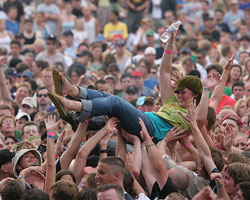Greening How You Get to the Festival
 lollapalooza2011.com
lollapalooza2011.comMost Music Festivals Feature Green Vendors and Recycling Competitions–but What About Fan Transportation?
All three of the summer’s biggest festival draws—Lollapalooza, Bonnaroo and Coachella—have some variation on the theme “Green Street.” Most sell food from local and/or organic providers. All have some sort of competition involving recycling. And all festivals are concerned about their environmental impact.
But what about the environmental impact they can’t control—the transportation choices of their attendees?
Last year, I was one of the 270,000 packed into Chicago’s Grant Park for Lollapalooza. Three friends and I split the 15 hour, 840-mile drive—and the gas money. While my friends stressed about seeing either the Foo Fighters or Coldplay, I stressed about that gas money. The stress wasn’t founded so much on my status as a broke college student, but on what that money represented. As the gas pump rang up dollar after dollar, I at first envisioned smoggy air, then thinning ozone, and finally, a post-apocalyptic world heavily influenced by The Road. Was the environmental impact of driving halfway across the country worth it, just to listen to music I could listen to on my iPod? One vanful of girls won’t result in a temperature increase of 5˚, but my friends and I were definitely not the only ones driving 15 hours to Lollapalooza.
The festival cannot directly control the transportation of its attendees. Imagine if Lollapalooza—happening Aug. 3-5 at Chicago’s Grant Park and featuring the Red Hot Chili Peppers, the Black Keys, Black Sabbath and Florence + the Machine—placed a ban on ticket buyers outside of a 100-mile radius. So what else can the festival do if they really want to reduce their footprint? The indirect carbon output from people driving or flying to the festival is most likely much larger than the event’s direct carbon output (things that the festival has control over, such as generators, recycling, solar power, etc).
However, festivals can persuade their attendees to be a little more sustainable. Lollapalooza offers the option to purchase a Green Mountain Energy Fan Tag for only $3. Check off the “Offset Your Carbon Impact Now” box and Green Mountain will purchase 220 pounds of certified carbon credits, which the Lolla website says is the equivalent of not driving your car 250 miles, or the amount of carbon stored in 13 trees.
Carbon credits are tricky—some say they are akin to buying out of responsibility, others that they are the only way we can continue to function and help the environment at the same time. Coachella and Bonnaroo don’t offer carbon credits. Instead, both festivals have a fairly extensive carpool network. Each festival website offers links to forums or other sites where you can coordinate with strangers living nearby who are also looking to carpool. Coachella—the indie pop fest that’s held in April in Southern California and has taken to sea this year for two cruises, starting Dec. 16 and Dec. 19 out of Fort Lauderdale, Florida, featuring acts like Pulp, Hot Chip and Girl Talk—calls their initiative “Carpoolchella” and offers an incentive for taking the carpool challenge. Every car with four or more passengers has the chance to win one of a few possible prizes, such as all access guest passes, merchandise vouchers or VIP tickets to Coachella for life. Bonnaroo, held in June in Manchester, Tennessee, also offers prizes, although they are not as exciting (sorry, Bonnaroo).
So while I now opt out of driving hundreds of miles to attend music festivals (because I truly am a broke college student), it makes me feel slightly better that festivals encourage rideshares and the purchasing of carbon credits. People from all over the country are going to flock to these festivals no matter what—might as well make the trip there as sustainable as possible and use renewable energies to power the festival itself.

